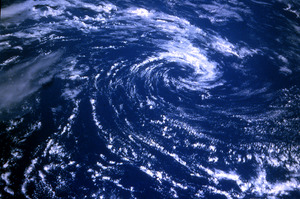Anticyclonic storm facts for kids
An anticyclonic storm is a type of storm that forms around a high-pressure center. In these storms, winds spin in the opposite direction compared to storms with low pressure. They can sometimes create strong supercell storms and even rare anticyclonic tornadoes. You can find examples of these storms on Earth, like the "Beast from the East" blizzard in 2018, and even on other planets like Jupiter and Neptune.
Contents
What is an Anticyclonic Storm?
Anticyclonic storms usually form in areas where the air pressure is high. In these high-pressure zones, air moves outwards and sinks downwards. As the air sinks, it gets warmer and drier. This is why anticyclonic storms often have fewer clouds than other types of storms.
These storms are often linked to cold weather and can bring big snowstorms. Because of something called the Coriolis effect, anticyclonic storms spin clockwise in the Northern Hemisphere (like North America and Europe). In the Southern Hemisphere (like Australia and South America), they spin counterclockwise.
Anticyclonic Supercells
Supercells are very strong, long-lasting thunderstorms. They form when there are powerful winds that change direction or speed as they go higher in the atmosphere. For an anticyclonic supercell to form, there needs to be a lot of energy to make the clouds grow big and strong with moist air.
A supercell has a spinning column of air that moves upwards, called an updraft. Usually, this updraft spins to the right. But sometimes, it spins to the left, which creates an anticyclonic supercell. These special supercells can cause hail storms, but they rarely produce anticyclonic tornadoes.
Anticyclonic Tornadoes
Tornadoes are like spinning funnels of air with very low pressure inside. Most tornadoes spin in a way that is called cyclonic. However, some rare tornadoes spin in the opposite direction, which means they are anticyclonic.
Even though tornadoes are low-pressure systems, the Coriolis effect (which makes large storms spin) doesn't really affect them because they are so small. Anticyclonic supercells can sometimes develop into these rare anticyclonic tornadoes.
Examples of Anticyclonic Storms
- Hartmut, Scandinavia (2018): From February 25 to March 4, 2018, a very strong anticyclone called Hartmut brought extremely cold air from Siberia. This caused a rare "anticyclonic blizzard" across Europe, known as the "Beast from the East." It brought freezing temperatures and lots of snow, especially to the British Isles.
- Neptune: In 1989, the Voyager 2 spacecraft found a huge anticyclonic cloud system on Neptune. This system had bright, high clouds and a spinning vortex, much like anticyclonic storms on Earth. Voyager 2 also discovered other storm systems on Neptune that showed anticyclonic behavior.
See also
- Anticyclone
- Anticyclonic tornado
- Great Red Spot



